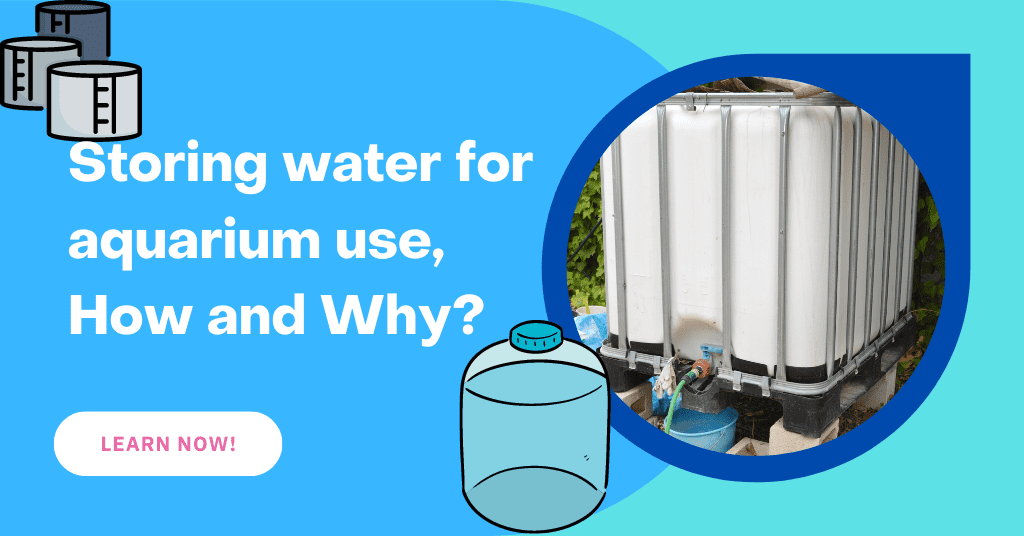Last Updated on November 6, 2021 by cmoarz
Storing water for an aquarium is always a good idea. There are a lot of reasons why you would want to do that, Such as dechlorination, easy access, Temperature control, etc. Before you start storing water, there are some things you are going to need to consider before setting up a storage system. But first, Why store water in the first place?

Why should you store water to use in your aquarium?
Table of Contents
This is a big question and it has a lot of answer to it. If you know exactly why you need to store water, You can skip onto the next section of this article.
There are so many reasons why someone would want to put water in storage containers. Not all tap water is made equal as any aquarium hobbyist will instantly be able to attest to. Everyone’s tap water is different.
Some might have almost no chlorine, Some might have way too much. Some cities might use chloramine instead of chlorine which is 10x more annoying to deal with.
Some might have soft water, some might have hard water. Some water might have too much iron or copper, Or any other sort of heavy metals or chemicals contamination.
So just right off the bat, Using tap water isn’t always straightforward for everyone and can be devastating to your aquarium if you were to use it straight from the tap.
So being able to store water to the side while you have time to treat the issues you face is very important for many of us.
And maybe that’s not you, maybe your water chemistry is just perfect straight out of the tap. That’s always nice! But you might still want to be able to store water for other reasons, such as temperature control and ease of access.
All those reasons aside, and no matter which one is you, It’s our professional opinion that the option to safely store water can be a mighty time saver for most aquarium hobbyists. Especially if you’re using an auto water changing system and of course, need a water storage setup.

Figuring out how much water you need to store
Knowing how much water you actually need for your fish room is probably the second biggest challenge when figuring out how your stored water system is going to work.
This is all going to depend on the size of the aquariums you have and how much water you want to have on hand without needing to refill all the time, or even considering having an auto refill and dechlorination station.
The more tanks you have, and the larger those tanks are, the harder it’s going to be to find a sufficient storage medium and a place to put that massive weight of water.
The more water you have to deal with, the more you need to consider where to put it and how to deliver that water to your aquarium, such as with a small pump.
If you just have a few 10 gallons then 2 5 gallon buckets will do for most 10-20% water changes.
After that, You will start to need to look for a larger container, such as water storage tanks for RV, water storage tanks for drinking, large plastic containers, Rubbermaid brute trash cans, etc.
A very large fish room with an automated water change system may require something large, like the size of a water storage tanks for wells, which can run way past 300 gallons.
A rule of thumb is you want to have enough potable water on hand to change out fish water for an entire week. Although this isn’t a rule.
Most water changes you do will probably only be 10-20%, so just do the quick math to figure that out for your tank gallon total.
Once you figure out exactly how much you are going to need, You also need to consider space constraints and how you’re going to get that water moving to where it needs to be.
The weight of some of these containers full is only going to be able to be placed on concrete floors such as basements. That’s also something you need to consider depending on how much water you intend on storing.

Choosing an appropriate container to store water
Your choice of storage containers is going to change based on your personal needs. Some might be just fine with a simple trash can filled with water, While others might need massive tanks.
If you want to have your water heated, You will need to have a container that can hold that heat in so you aren’t burning up electricity needlessly due to bleeding heat loss.
This can also be accomplished by simply surrounding the outside of a container with insulation.
Tank materials should be food-grade plastic, stainless steel, or other food-grade materials.
You should never reuse a container that has been used previously to store or transport toxic materials, Like pesticides, petroleum products, or other chemicals. Anything you wouldn’t want to be leeched into your fish tank should be avoided!
If you go with a plastic container, Plastic types #2 #4 and #5 are generally considered safe and strong. #1, #3, #6, #7 are definitely to be avoided.
When choosing your container, You will need to consider other things as well, Such as the need to drill holes to run pumps (pond pump) and air hose or PVC. Plastic is much easier to deal with than steel or aluminum if you do not have the tools to do so.
If you intend on storing salt aquarium water for your saltwater aquariums, You will also need to take the degradation properties of salt into account, and should probably avoid metals storage containers.
Some common options to choose from would be:
- Old plastic water barrel (or barrels)
- 5-gallon bucket for smaller tanks (I’ve included a link but these are far cheaper to buy offline)
- Large water storage tanks for wells
- Water storage tanks for rv’s
- Large outdoor water storage tanks for drinking water (Large white plastic ones).
- Simple Rubbermaid brute trash cans etc
Some of these are rather expensive, so be sure to check water tanks for sale used on Craig’s list and Kijiji, eBay, etc. Remember to always get a detailed past history of used containers to avoid toxins and other nasty surprises.

High Tech Vs Low Tech options for treating tap water and storing water
Choosing whether to go low tech or high tech is also a deciding factor in which container you are going to need to use.
Unfortunately, there is no definitive “low tech” method and “high tech” method, and it’s more of a sliding scale of complexity.
Having a heater and a tiny pump vs haveing a full automated water change system with auto refiller for the tank and timed release of dechlorination chemicals and digital water testing.
Maybe having filters in between your storage container and water source as a means of filtering out chloramine, Or perhaps to change hard water to soft water, or vice versa.
Depending on your needs your setup could change from low tech “it holds water Nuff said” to “Gogo gadget” real quick and it all needs to be taken into account before you plan out what you need.
Mind you, don’t let me scare you off. If you are just a normal person with a small single fish tank or 2, Very little of this is probably going to apply to you. Personally, when I first started out, I just had 3 5 gallon buckets. 2 with fresh dechlorinated water, And a waste bucket for the used tank water change.
With that said, Get what you are sure to need, But be sure to leave room for expansion in the future. It’s always “Just one more tank” after all.
Storing Saltwater? – These Containers Are Saltwater Safe
While many containers can technically hold saltwater, the recommended plastic type is HDPE [2]. It’s been tried and true and the defacto standard for most saltwater reef owners. (Think Rubbermaid brute trash cans)
If you have an option to go with metal, You should consider stainless steel. You will want either 304/L, 316/L, or Duplex stainless steel. These steels will offer the most resistance to corrosion, however, they will eventually begin to rust after a long time.
How long can you store water for aquarium?
Freshwater can be stored for a relatively long period of time. However, if you intend on doing so you should have enough airstones in the container to keep the water moving and oxygenated and it should be stored away from light.
Chances are you will use the water within 2 weeks, but if you do not, that’s fine.
The saltwater on the other hand should be used within 48 hours after mixing the salt. An airstone is a must in a saltwater holding tank, as well as the addition of a powerhead or similar. This will keep the saltwater safe if you need to go beyond 48 hours.
About
Owner of AquariumGravel.com and also owner of actual Aquarium Gravel believe it or not! ;). Setting up beautiful aquarium sceneries and habitats since I was very young. Enjoy!
- Web |
- More Posts(290)

